 
Colectomatic: 1954-1960
Heil Joins the "Packer Wars"
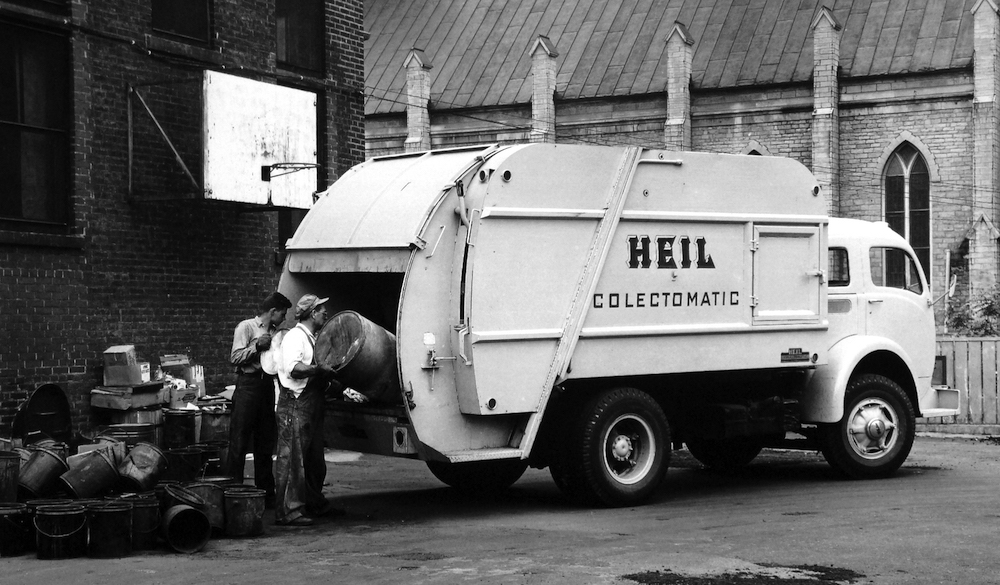
The final production type Colectomatic, introduced in July of 1954 and produced through 1960
THE 'BROWN-URBAN PATENT' COLECTOMATIC (1954)
Probably as result of testing the Murphy-type Colectomatic in 1953, Heil began a crash program to streamline virtually every feature of their new packer. As a result, an all-new Colectomatic was announced in a July 1954 advertising blitz. It shared only its name and the basic operating principle with the earlier prototype. Harold Brown and George Urban did a remarkable job of transforming Murphy's concept into the body that would become Heil's top-selling packer of the 1950s, and catapulting the company to a leading position within the industry. In addition to being of solid engineering effort, the new Colectomatic was also one the most attractive bodies of the era, which probably helped sales even further.
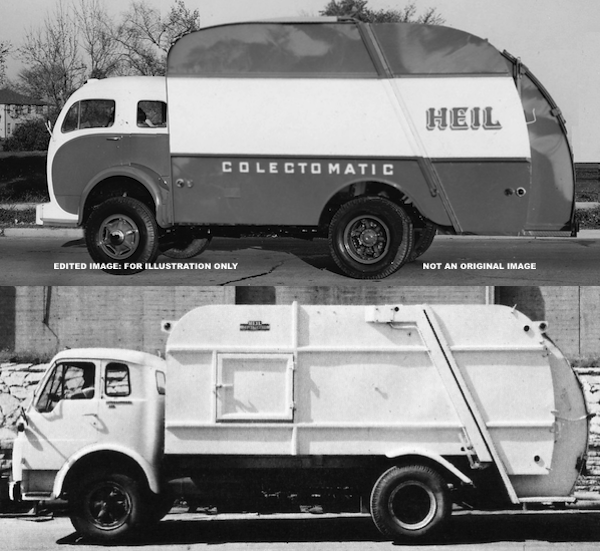
Comparison of the 1953 Murphy prototype model (top) and the 1954 Brown-Urban production model (bottom).
Note the difference in the size and shapes of these tailgates, and the absence of skirting on the 1954 version.
Like the Murphy prototype, the improved 1954 model had a hinged hopper and pivoting packer panel powered by two roof-level hydraulic cylinders. The big change was in the synchronization of hopper and blade, which were interconnected by bell cranks and "lost motion" links. The latter were telescopic links which could impart direct thrust in one direction, but would extend in the other direction a pre-set distance without imparting any movement. This was done with simple internal pistons, rods and springs, and was not hydraulic. To raise the tailgate, the bell cranks were simply locked to prevent their normal motion, causing the extending hydraulic cylinders to raise the tailgate instead of operating the packer. Though it may seem overly complex by modern standards, the Colectomatic was a simple design for its time, and a huge improvement of the original prototype. Almost all of the moving parts were located behind covers on either side of the tailgate, which gave easy access for service.
The first Colectomatics were equipped with an automatic hopper closure door, which kept the hopper sealed off during the packing cycle for safety. The door lowered automatically as the cycle commenced, and tripped open with a spring-assist by the descending bucket after the cycle completed. Later versions are known to have been built without any hopper closure at all, and presumably both versions were available during later production.
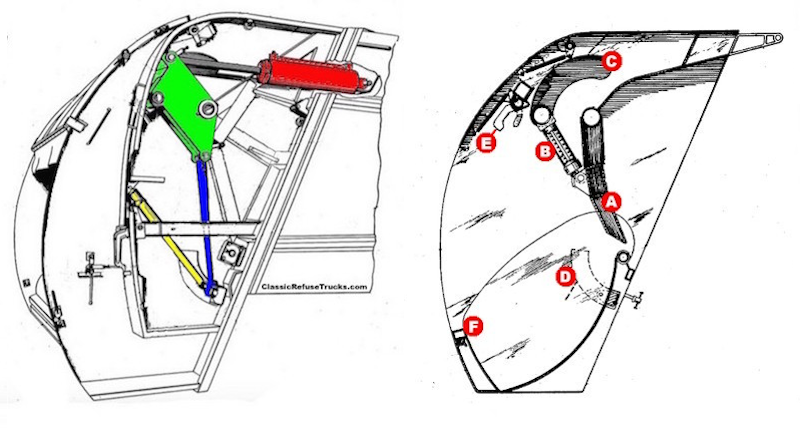
External components are shown at left, with most of the cables, springs and smaller parts omitted for clarity. The hydraulic cylinders (red highlights) are connected to the bell cranks (green highlights), which operate both the packer blade and hopper bucket. An arcuate slot is visible behind the top of the crank, following the path of the links driving the packer plate. The bucket lift links (blue highlights) are actually two-piece telescopic links, which will extend a short distance before any exerting pull on the bucket. Shock absorbers (yellow) prevent the bucket from slamming the body during its descent.
Internal components are shown at right: (A) packer panel, (B) packer "lost motion" link, showing internal spring, piston and rod, (C) arcuate slot for travel of packer link, (D) arcuate slot for travel of bucket lift bar, (E) arrester hook for bucket, (F) bucket lip which locks to arrester hook.
|
OPERATING CYCLE
There are no detailed technical drawings of the Colectomatic cycle.
Refer to the illustrations above when reading the following descriptions:
|
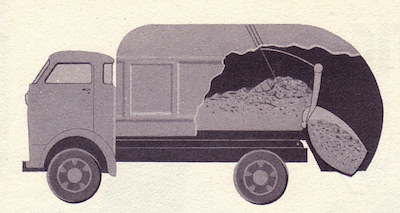
Before start of cycle, refuse is loaded into the hopper to a level below the tip of the packing panel. Any previously loaded refuse is retained within the body by the panel.
|
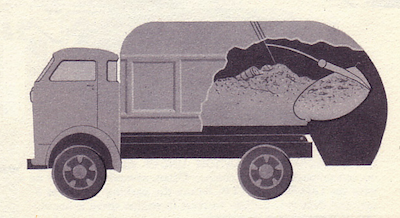 At start of cycle, hydraulic rams retract, pulling the bell cranks forward. The packer blade "lost motion" cylinders push against their internal springs, and meeting no resistance, they pull open the packing panel until it reaches its rear stops. The bucket lift sliding links initially expand telescopically until they "bottom out" internally, and begin to lift the bucket bar, which extends under the loading bucket through curved slots in the lower tailgate.
At start of cycle, hydraulic rams retract, pulling the bell cranks forward. The packer blade "lost motion" cylinders push against their internal springs, and meeting no resistance, they pull open the packing panel until it reaches its rear stops. The bucket lift sliding links initially expand telescopically until they "bottom out" internally, and begin to lift the bucket bar, which extends under the loading bucket through curved slots in the lower tailgate.
As the bell cranks must continue rotating to lift the bucket, and the packer panel cannot move rearward any further, the pistons in the "lost motion" packer links now meet resistance. They begin to fully compress their internal springs, and their rods extend out of the cylinders until the bucket is raised.
|
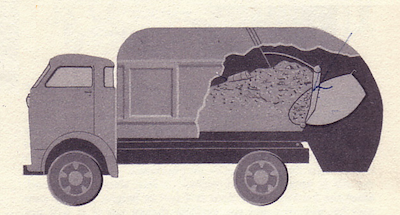
Next, the hydraulic cylinders reverse, rotating the bell cranks rearward. This causes the packer "lost motion" cylinders to retract their springs, and then begin directly pushing the packer panel forward. Refuse is rolled and packed into the body.
The bucket is still locked in position by the arrester hooks as the packer sweeps it clean. Despite the movement of the bell cranks, the bucket lift link motion is "lost" as the upper and lower link sections collapse into each other. The bucket bar and lower sections of the lift links are held in their uppermost position by the shock absorbers.
|
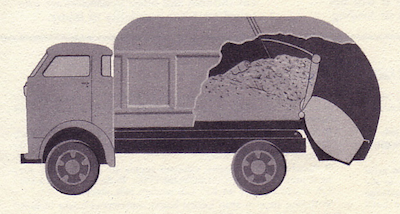
When the packer blade reaches its innermost travel limit, the bell cranks trip the arrester hooks, releasing the bucket, which falls back by gravity to the loading position. The weight of the bucket overcomes the resistance of the shock absorbers, but they slow down and cushion its descent, preventing it from damaging the tailgate. Previously loaded material is retained within the body.
Elapsed time for this complete packing cycle is approximately 15 seconds.
|
Early versions featured a hopper closure door, which was spring balanced and lowered automatically as the cycle was started. Upon completion of the packing cycle, the falling bucket tripped a release which then opened the door.
The cables and linkages which operated the door can be seen in the photo below. Refer to the patent text for a detailed description of door operation. Within a few years, Colectomatics were being produced without the hopper door, which was presumably made optional.
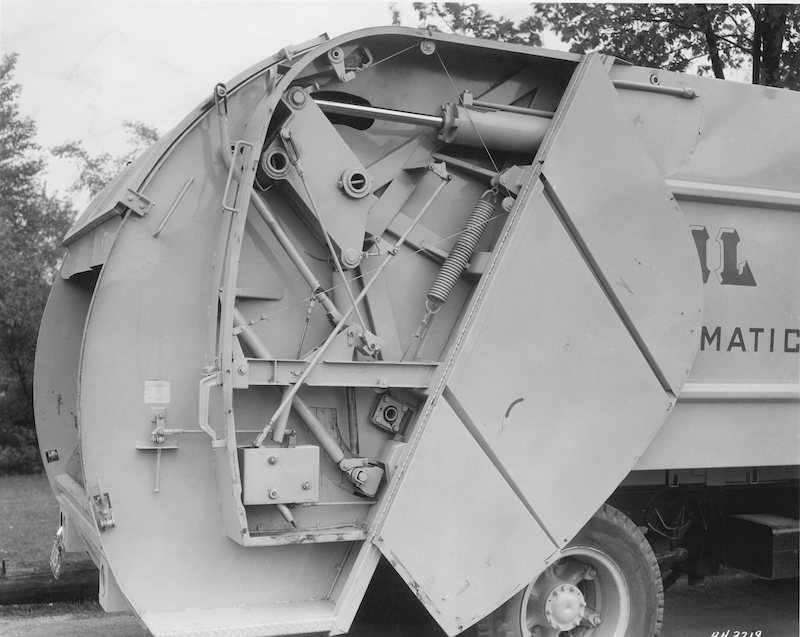
The cycle could be reversed or stopped at any time. In the event that the packer jammed between a solid object and the raised bucket, and would not move in either direction, the bucket arrester hooks could be manually released by use of a bar inserted into an opening above the door. Once released, the jam-up could be cleared by cycling the packer panel.
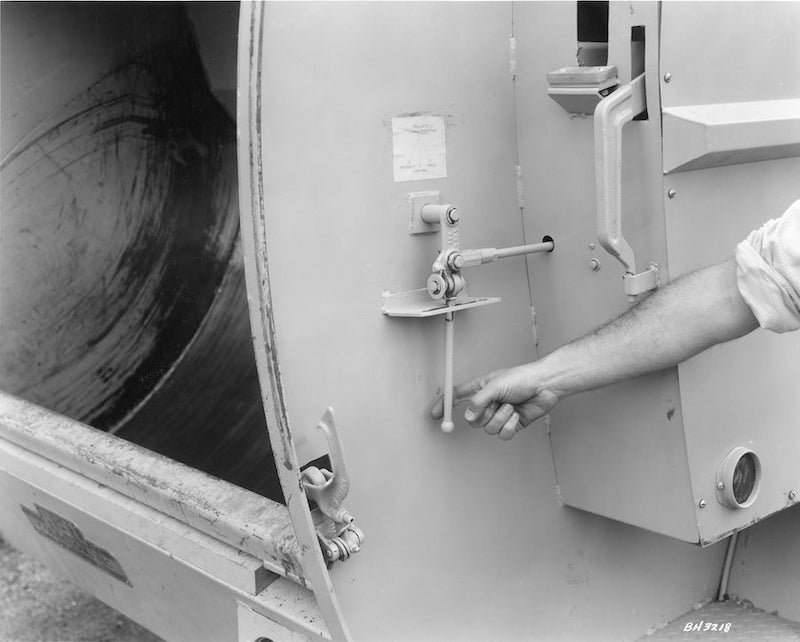
A single lever controlled all packing functions
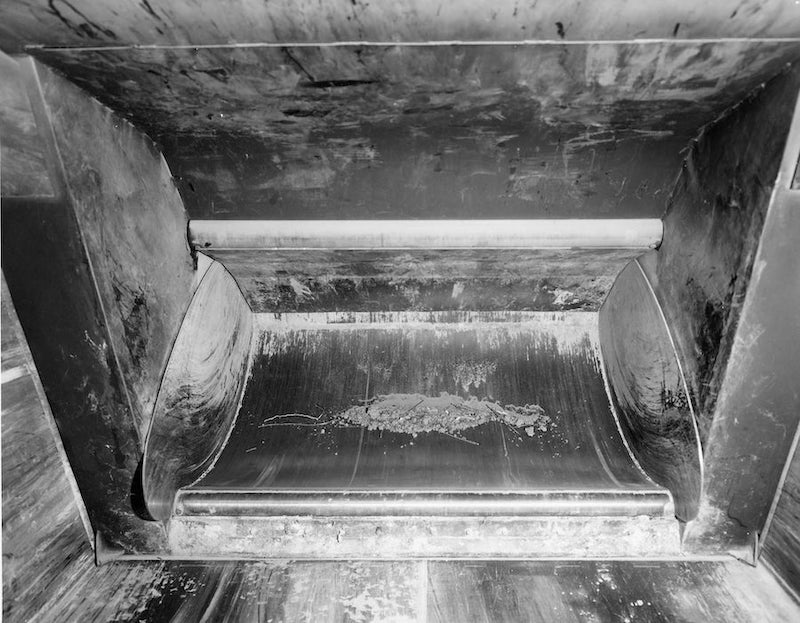
View from inside the body; hinged hopper is shown fully raised, and the packer panel is fully retracted (rearward), behind the charge of refuse...
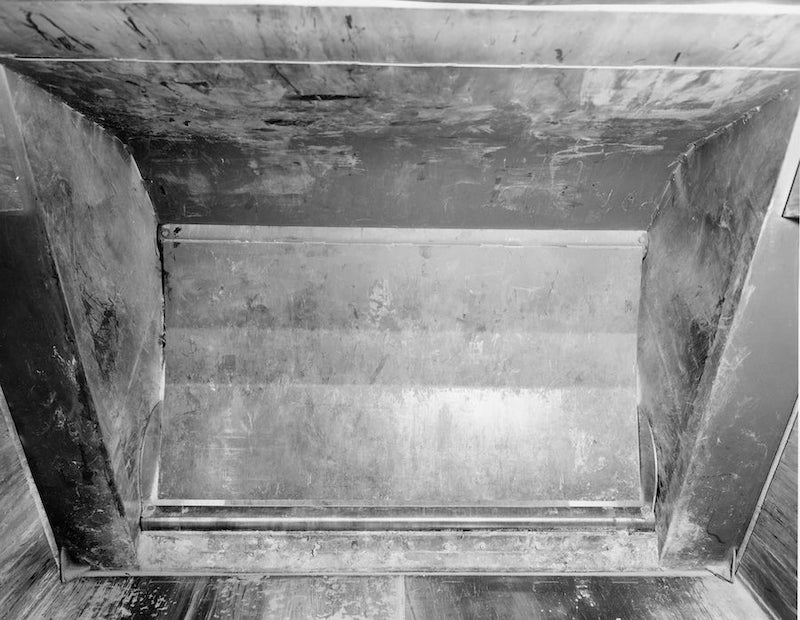
...and packer panel fully extended into body, sweeping refuse from hinged hopper
|
The new Colectomatic was officially announced in a national advertising campaign starting in July 1954. Heil continued to advertise their new packer aggressively in trade publications through early 1957. The hopper featured a low loading height, and its 1.25 cubic yard capacity was more than accommodating for its day. Colectomatic was initially offered only with a 16-cubic yard body, but 13 and 20-cubic yard models were added by 1955. A single-cylinder Heil twin-arm hoist was used for dumping the body, with a dual-cylinder version being standard on the big 20-yarder. Mike Murphy, who had designed the first Colectomatic, was made supervisor of sales for the new model, and their extensive dealer network was soon selling them to contractors and municipal operators across the nation. Murphy retired in 1964, and must have taken great satisfaction in seeing his invention succeed so phenomenally.
With the Colectomatic, Heil was now ready for the packer wars of the 1950s, and competitive with anything on the market. Their Colecto-Pak remained in the lineup for a little while longer, then was quietly discontinued. The same fate befell the other bucket loaders on the market, which were rendered obsolete by the rapid advances of rear-loading packers. Evidently aware of where the business was headed, Heil sold their Heiliner construction equipment division to International Harvester in 1954. Refuse bodies, and particularly the rear loader, were in high demand, and Heil would emerge from the 1950s as one of the "big three" names in the industry. Along with Leach and Gar Wood, these companies would compete vigorously with each other in the decades to come.
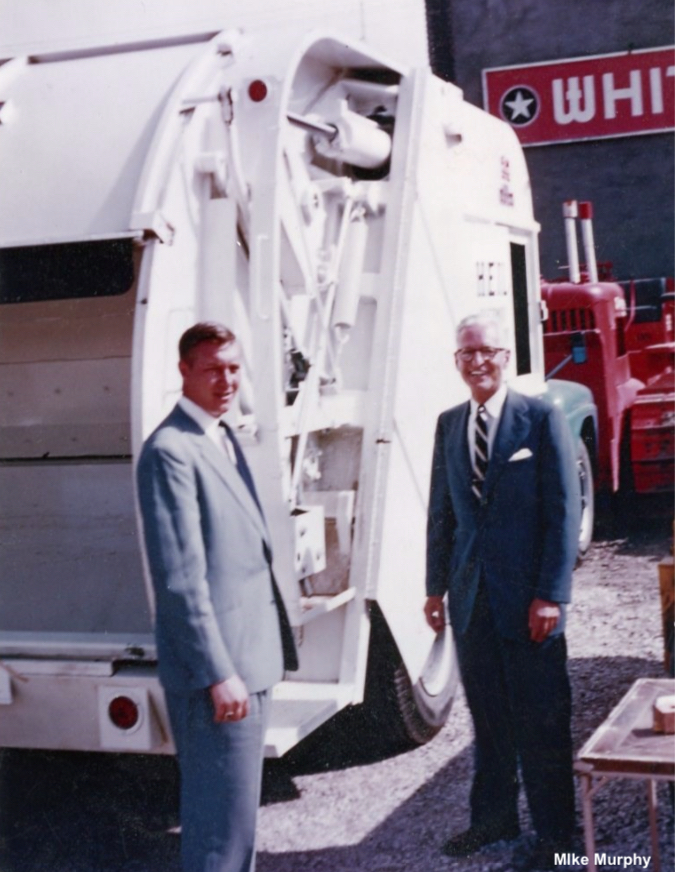
Inventor Mike Murphy (at right) with a Colectomatic demonstrator in 1955
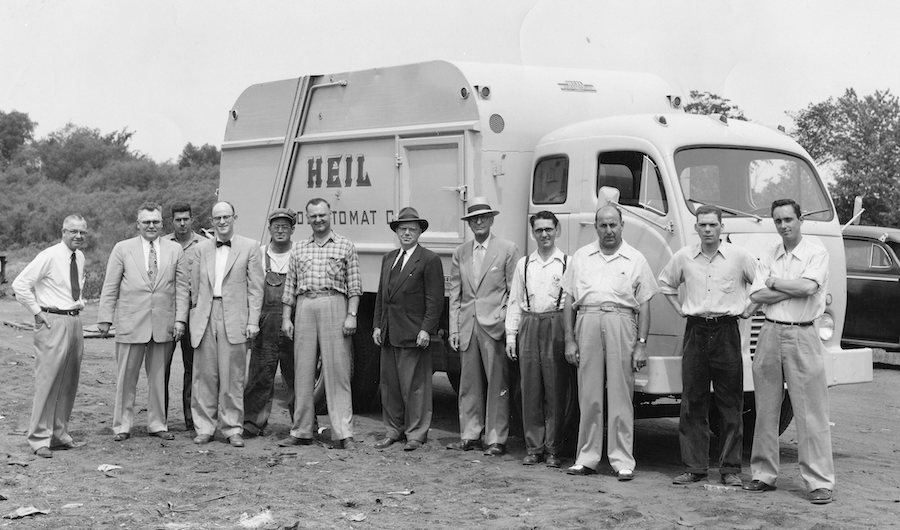
Heil reps and customers pose for a photo at a Colectomatic demonstration
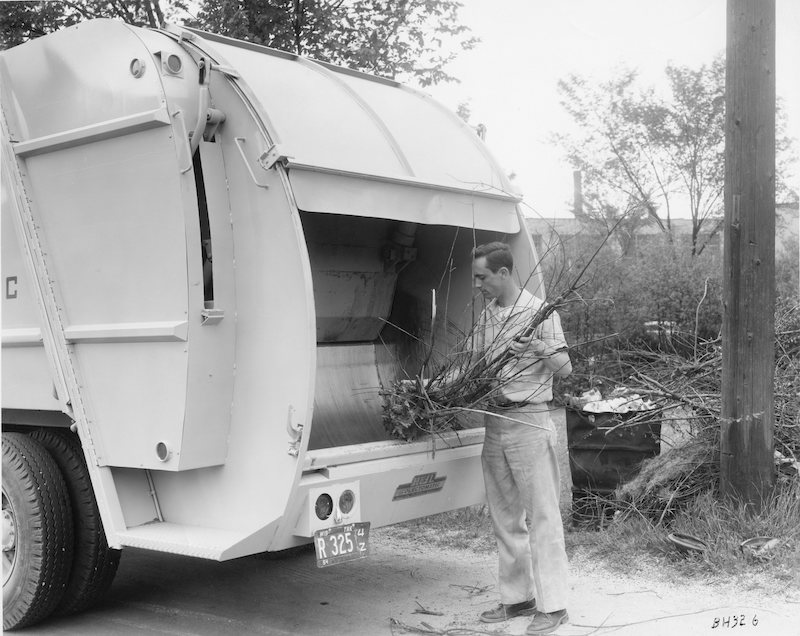
Wide, spacious hopper made the Colectomatic compatible, if not superior to, contemporary rivals Load-Packer, Packmaster and Sanivan
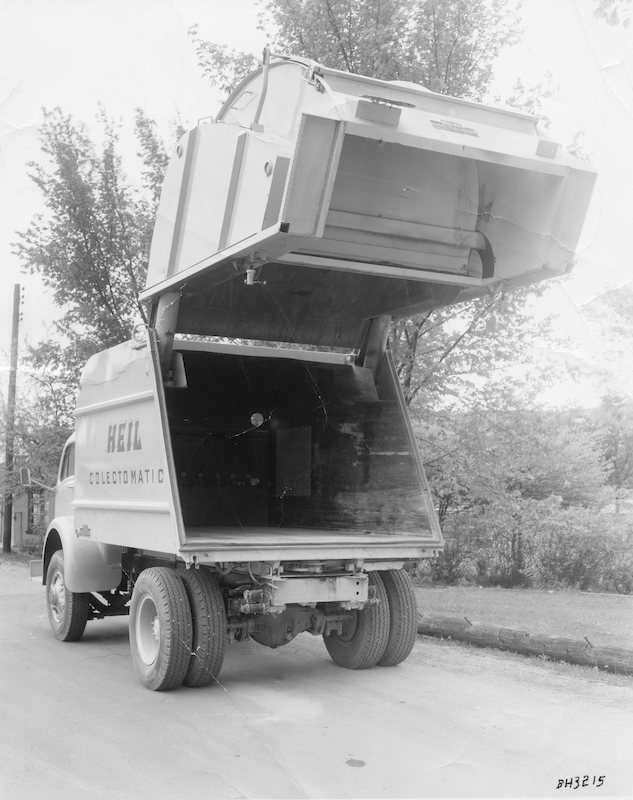
A view inside the body; packer cylinders also raise the tailgate
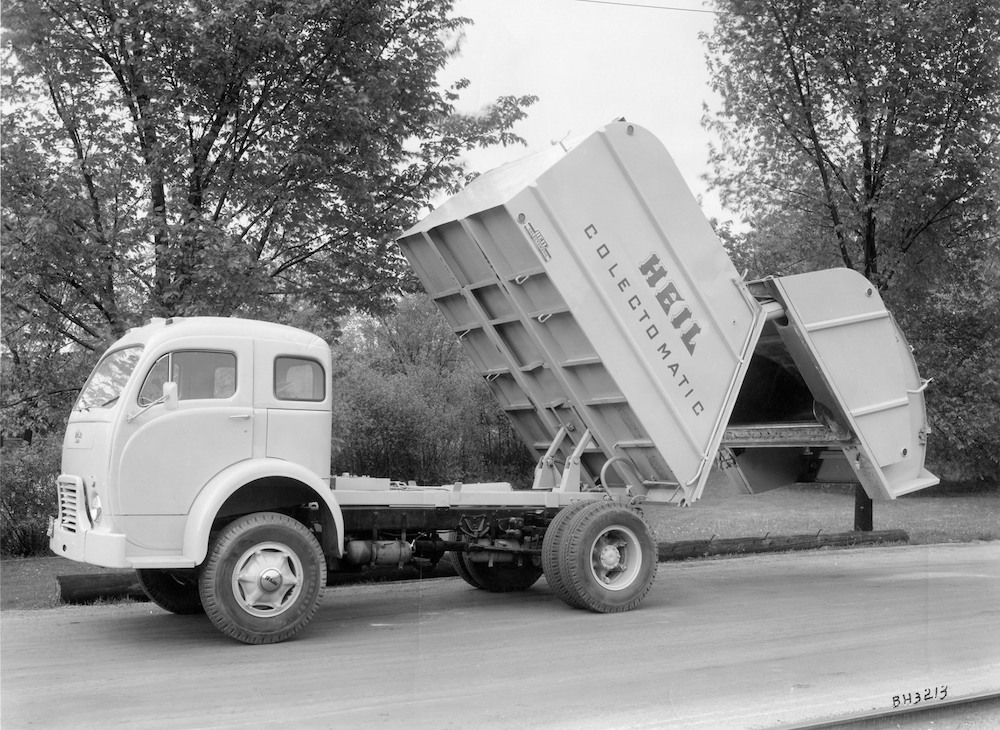
Heil twin-arm hoist does the heavy lifting
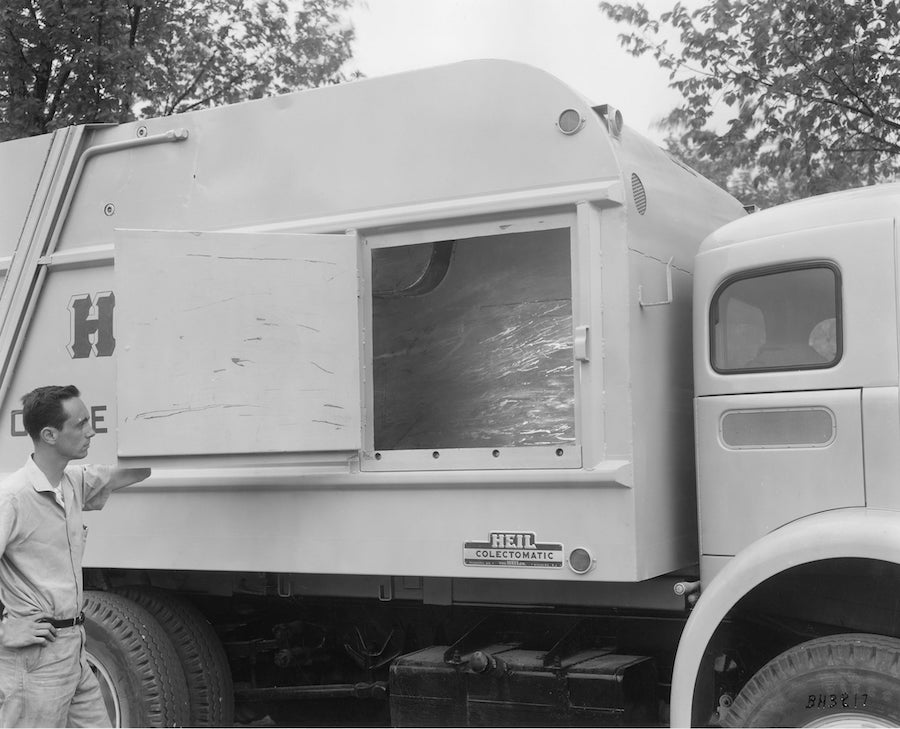
Side loading door for bulky objects
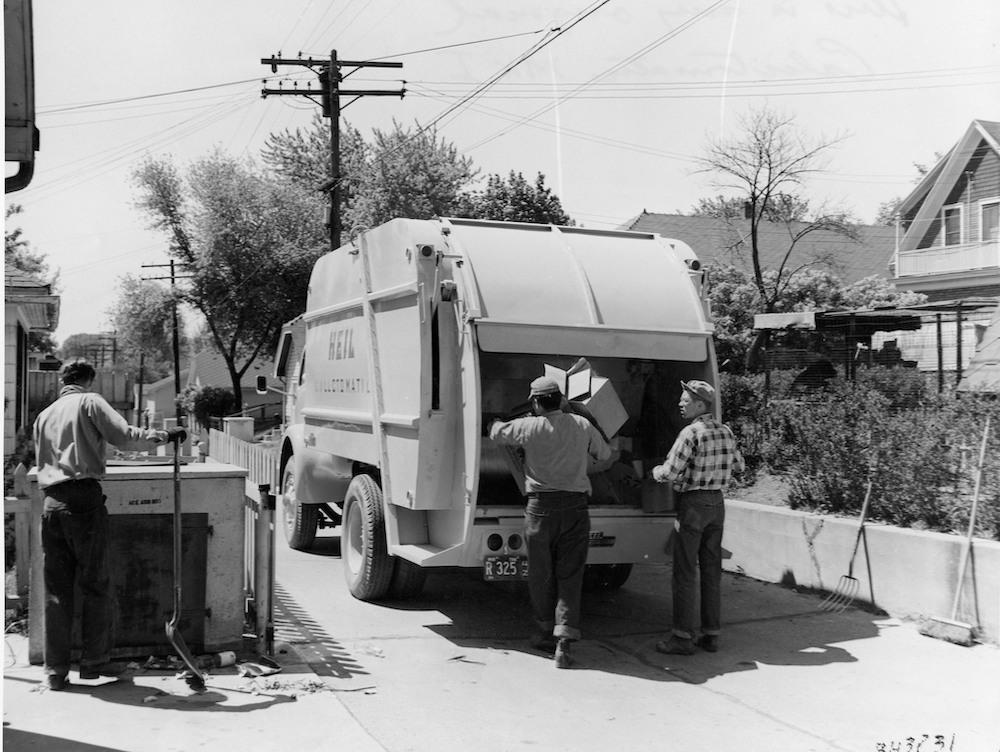
Alley cleanup demo, probably in Milwaukee
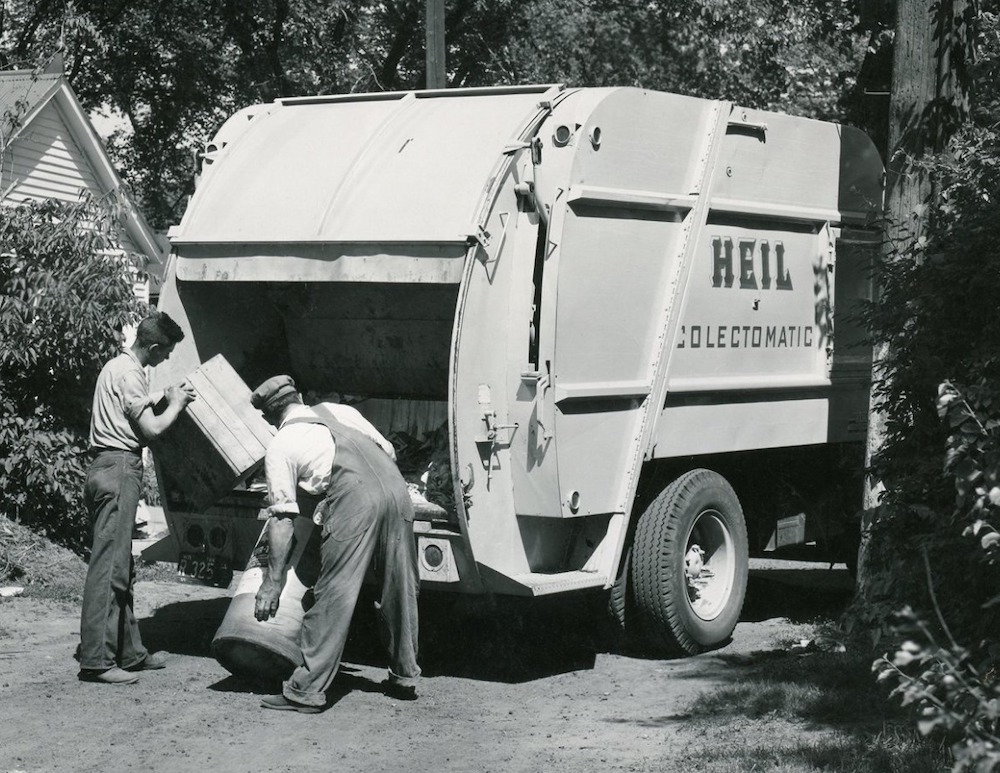
This factory demo photo was used in the original Colectomatic brochure, as were many of the others shown above
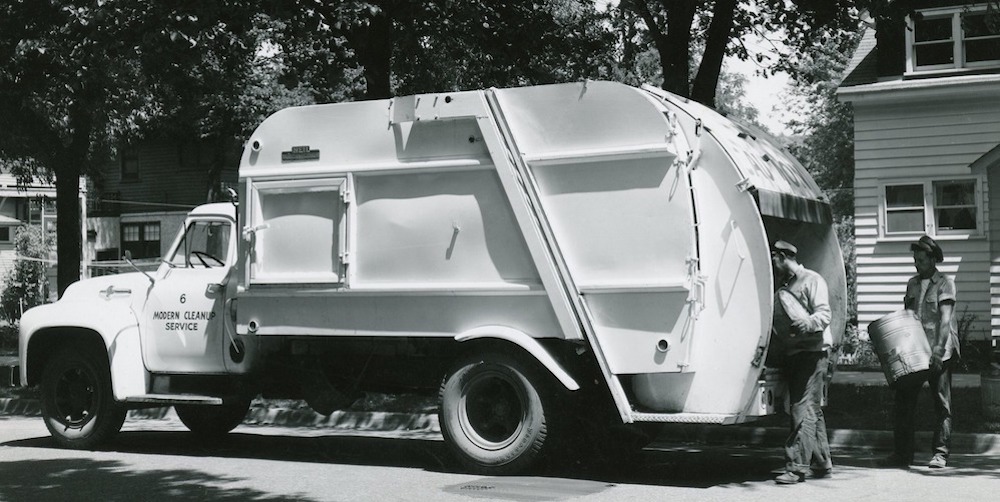
This factory photo appeared in several trade ads during the mid-1950s
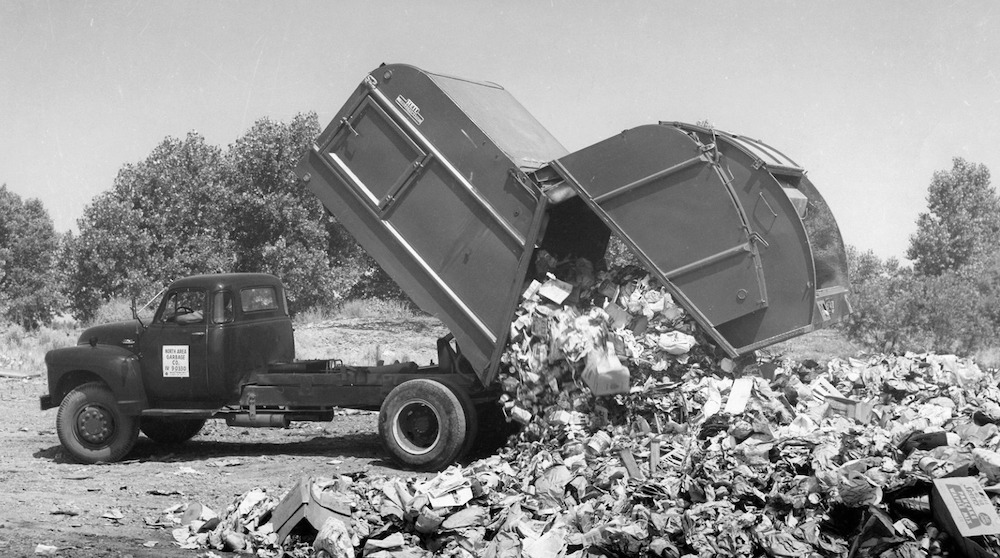
Tilt-to-dump Colectomatic used packing rams to also raise tailgate
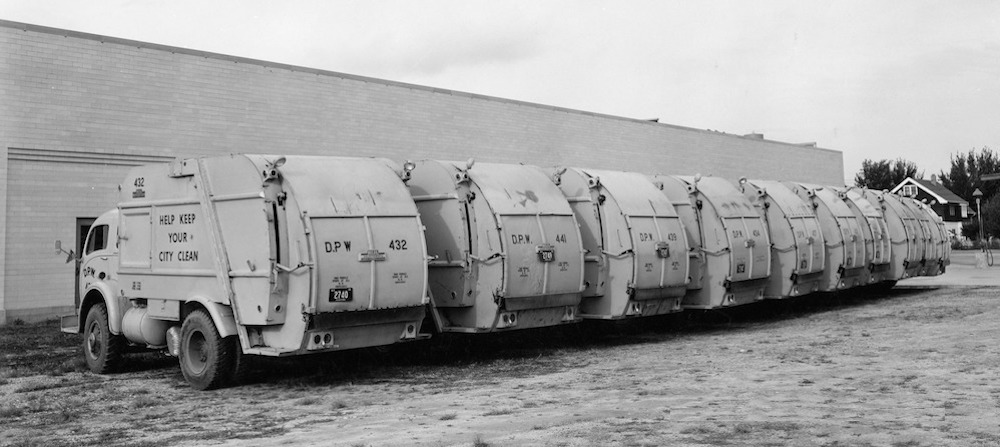
Fleet of Milwaukee Colectomatics on White 3000 tilt-cabs
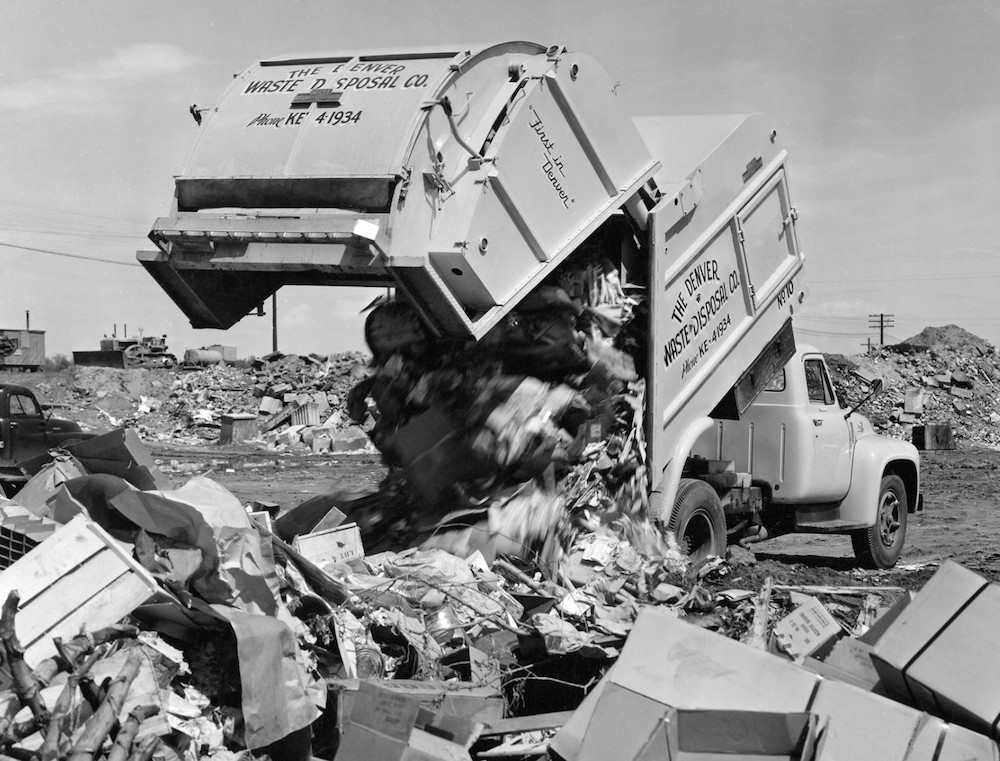
Another factory photo that was used for a 1957 trade ad, with hauler markings airbrushed out
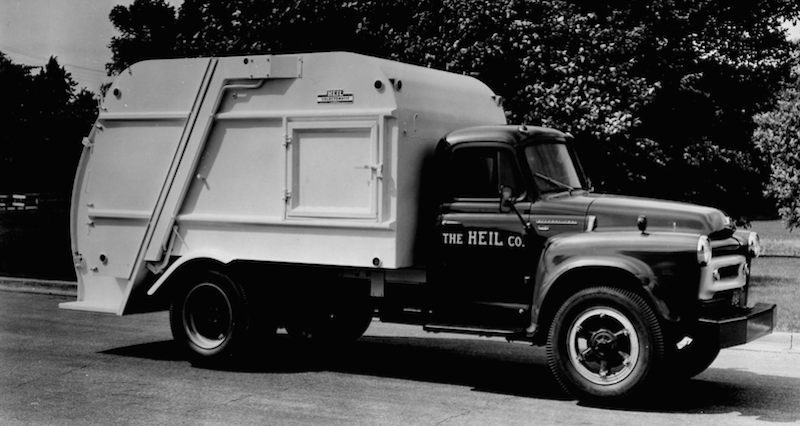
The compact 13-cubic yard model which arrived for '55
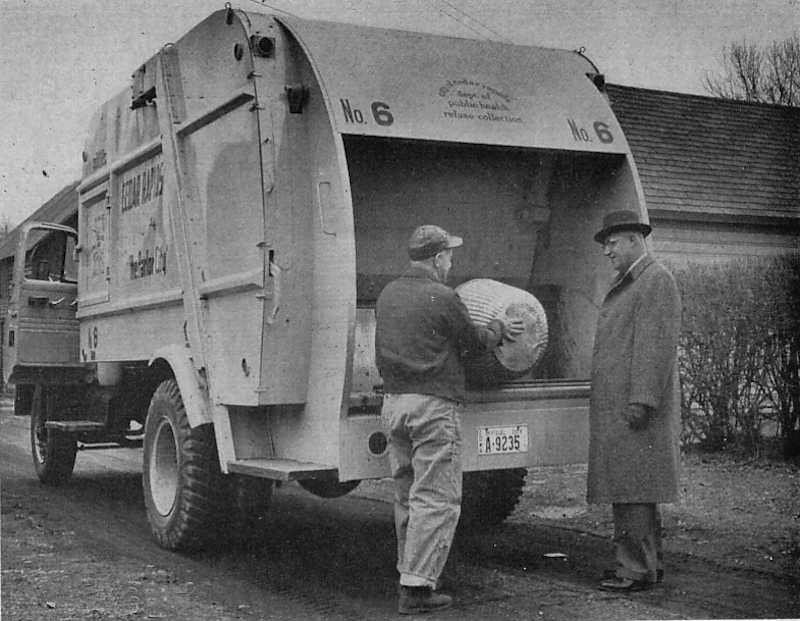
Later-model 16-yard Colectomatic, with hopper door delete option. One of 11 Colectomatics owned by Cedar Rapids, Iowa in 1957.
The city replaced a fleet of 10-yard Heil Colecto-Pak bucket loaders, a design rooted in 1920s technology, with modern Colectomatics
The "lost motion" cylinder, a spring-loaded link which transmits power from the bell crank, is visible at the right-hand side of the packer panel.
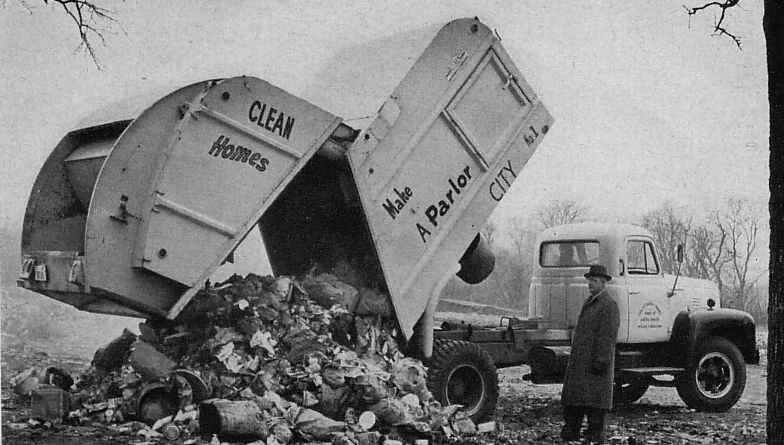
Cedar Rapids truck #1 at the dumpsite
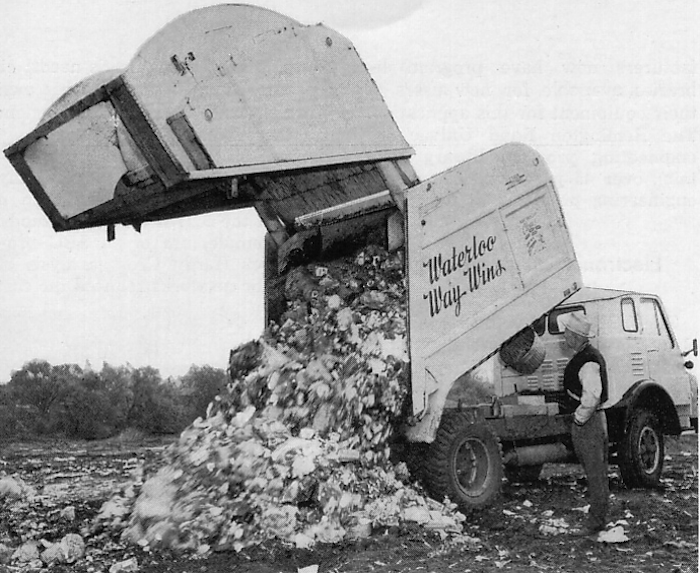
Waterloo, Iowa also replaced Colecto-Paks with Colectomatics in the late 1950s.
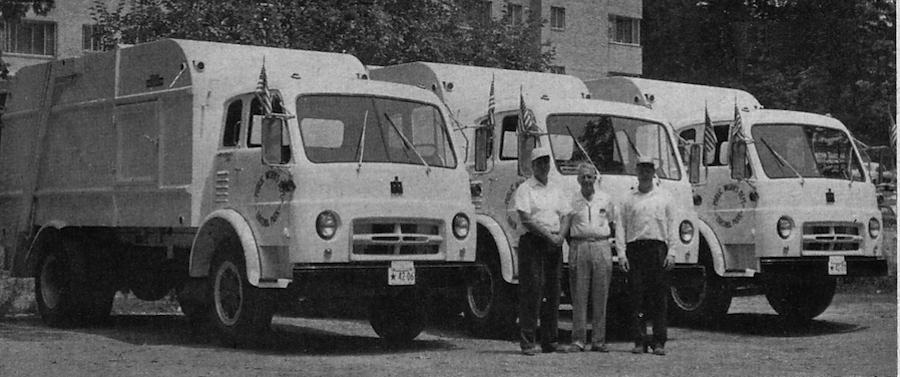
A suburb of the Nation's Capital, Takoma Park, Maryland switched to 20-yard Colectomatics in April of 1956. Each was mounted on an International Harvester CO-225,
for a total cost of $13,000.00 each. Four trucks replaced the old fleet of five, and daily landfill trips were reduced by over half, enabling collection routes to be combined
and expanded. Crews took pride in their new trucks, and a friendly competition began to see which could collect the largest payload.
A load of 14,070 pounds was the record, and daily dry-weather averages were typically over 10,000 pounds.
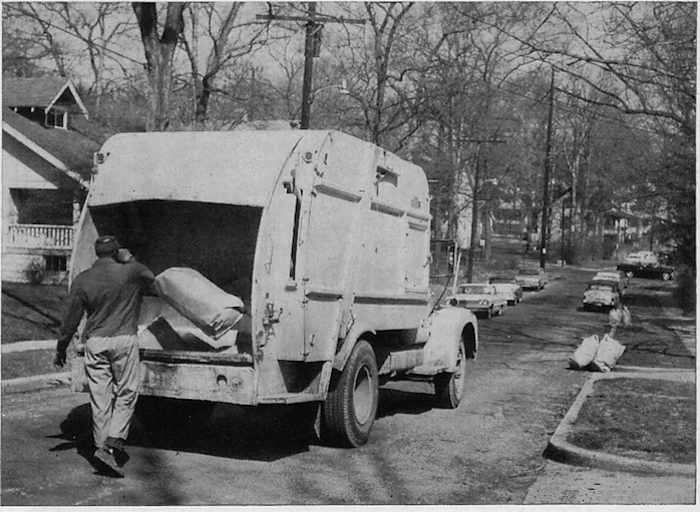
An older Colectomatic on the job in Riverdale, Maryland, another D.C. suburb. When this photo was taken in 1964,
Riverdale had recently adopted the Westvaco paper sack collection system, which eliminated metal cans.
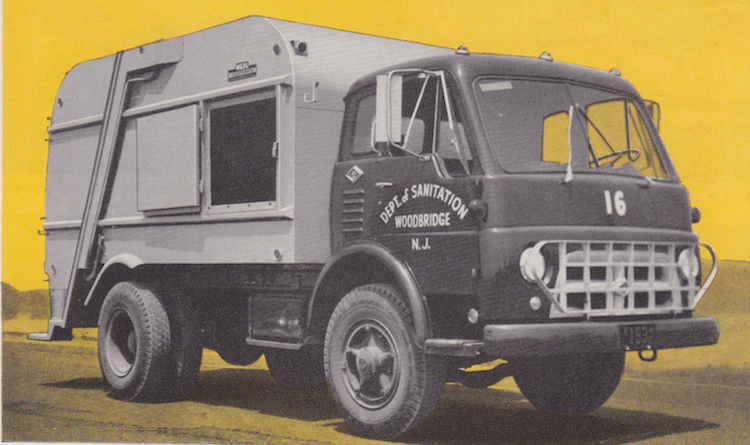
16-yard Colectomatic on Diamond T chassis for Woodbridge, New Jersey. Heil's branch factory at Hillside
helped them compete in the New York area and other eastern cities
PATENTS:
|
Patent # |
Description |
Inventor |
Assignee |
Date |
|
US2798624 |
Refuse Body Loading Mechanisms (Colectomatic) |
Brown, et al |
Heil Co. |
March 23, 1955 |
REFERENCES
American City Magazine, March 1954, page 215 (Heiliner sold to International Harvester Co.)
|



7/2/16 (updated 12/19/21)
© 2016
All Rights Reserved
Photos from factory brochures/advertisements except as noted
Logos shown are the trademarks of respective manufacturers
|
| |